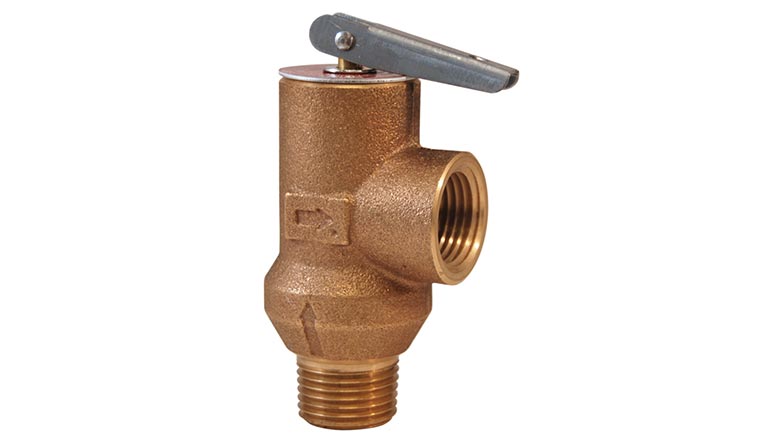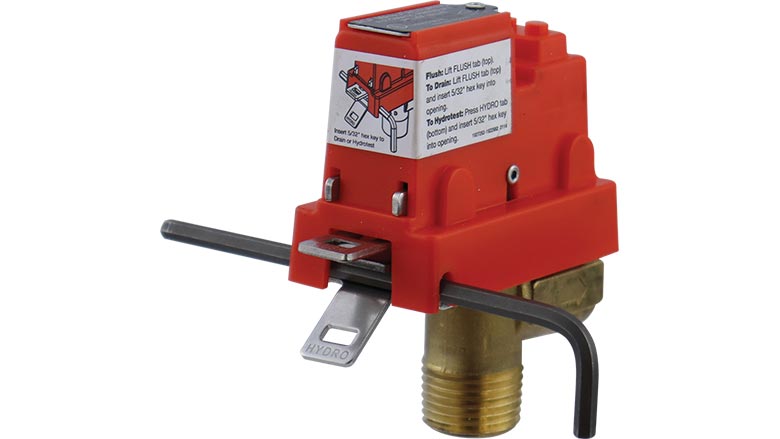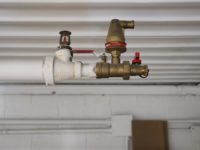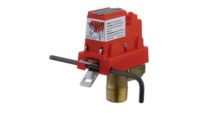Pressure relief valves protect fire sprinkler system components by relieving excess system pressure from supply surges or temperature changes. Since the 2010 edition, NFPA 13: “Standard for the Installation of Sprinkler Systems” has required pressure relief valves to be installed on all wet pipe fire sprinkler systems. But picking the correct relief valve for a specific system does need a little preplanning. By knowing the desired static pressure of the system and by reviewing the UL and FM Standards regarding the required operational characteristic of relief valves used on sprinkler systems for guidance, one can deduce the best rating for a relief valve on any system.
While field adjustable pressure relief valves may be tempting due to the flexible rating, they are often being used in a manner that violates the FM Standard. Their ability to be adjusted by anyone can introduce the very risks to the system that the NFPA 13 requirement was meant to eliminate. Factory-set relief valves are the best option due to a tested range of features proven to serve the system well.

NFPA 13 relief valve requirements
Before the 2010 edition, NFPA 13 only required relief valves on gridded wet pipe systems or on the discharge side of the pressure-reducing valve. In the 2010 edition, they expanded the requirement to all wet pipe systems:
“7.1.2.1. Unless the requirements of 7.1.2.2 are met a wet pipe system shall be provided with a listed relief valve not less than 1/2-inch (12mm) in size set to operate at 175 psi (12.1 bar) or 10 psi (0.7 bar) in excess of the maximum system pressure, whichever is greater.”
The only exception this edition supplies is “where auxiliary air reservoirs are installed to absorb pressure increases” (7.1.2.2). To summarize, every wet pipe system needs a listed pressure relief valve no smaller than 1/2-inch in size.”
What makes a “listed” valve?
What makes a pressure relief valve “listed” by NFPA 13 standards? In the 2010 edition, the term “listed” is defined as:
“3.2.3* Listed. Equipment, materials or services included in a list published by an organization that is acceptable to the authority having jurisdiction and concerned with the evaluation of products or services, that maintains periodic inspection of production or listed equipment or materials or periodic evaluation of services, and whose listing states that either the equipment, material or service meets appropriate designated standards or has been tested and found suitable for a specified purpose.”
Essentially, this means that a third-party organization acceptable to the authority having jurisdiction must inspect a component and deem it “listed” by their standards. Two common organizations that perform this function in the fire sprinkler industry are UL and FM. So, a “UL Listed” or “FM Approved” relief valve can meet that part of the NFPA 13 requirement.
Relief valve rating requirements
Both UL and FM have standards to guide the relief valve rating choice for a system. The valves must open and close within a range of their ratings. FM requires opening at no less than 85% of the rating, while UL requires opening at a pressure no greater than 105%. UL and FM require closing within a percentage below opening.
A rule of thumb to help guide what “rated” pressure relief valve to choose is to compare the system’s desired static pressure to the outcome of the equations. Multiply the relief valve’s factory-set rating by 90% to determine the estimated minimum opening and by 80% to determine the estimated minimum closing.
As an example, if a relief valve is rated at 175 psi, and you applied the two equations mentioned above, you would end up with 158 psi and 140 psi, respectively. If the desired system static pressure is below 150 psi, a 175 psi rated relief valve is usually the best choice. But if the desired system static pressure was closer to 165 psi, there would likely be a conflict.
If the pressure relief valve installed is designed to open at or below the desired system static pressure, the valve might constantly relieve “excess pressure” while the system’s pumps continue to try to meet the desired system static pressure. The proper relief valve rating for a system with a designed 165 psi static pressure might be close to or slightly higher than 200 psi. But it is equally important not to install a pressure relief valve with too high a rating, as that might put the system at risk of being over-pressurized.

Risks of adjustable pressure relief valves
Adjustable pressure relief valves are sometimes used because of their ability to be adjusted in the field. However, a range of problems comes with the ability for anyone to “adjust” such a critical system component.
Without an understanding of UL and FM operational characteristics described above, some might think a relief valve is faulty when it opens below its rated pressure. Usually, it is operating as designed and protecting the system. With an adjustable relief valve, anyone can come along and adjust the pressure rating to stop the “leaking.” This puts the system at risk because the relief valve is now not operating in the intended pressure range.
After a system is initially installed, modified or maintained, best practices require hydrostatic pressure testing above the desired system static pressure to check for leaks. For this testing to be successful, it must occur prior to a pressure relief valve, designed to keep the system at the desired static pressure, is installed. As a result, the relief valve is typically installed after hydrostatic testing occurs.
Some manufacturers and system installers use adjustable relief valves as a shortcut. Their intention is for the relief valve to be adjusted completely closed for hydrostatic testing and then adjusted open to hopefully the correct pressure after the testing. However, since it is adjusted in the field, there’s no way to guarantee that it is at the correct pressure.
According to the “FM Approvals Standard for Trim Water Pressure Relief Valves 1/4-inch through 2 1/2-inch Nominal Size,” Class #1359, section 3.2.6 specifically states that, “no field adjustments to the set pressure is permitted.” Therefore, the action of adjusting the relief valve to allow a testing pressure above the designed static pressure and then adjusting the relief valve again back to hopefully the correct pressure would likely violate the FM Standard.
Additionally, section 3.2.7 states, “A manual external handle may be provided by the manufacturer as an option for exercising the valve. By cycling this handle, the valve plug may be exercised while under pressure, to flush debris of other foreign matter off the seat. This optional external handle will have no effect on the set pressure of the valve.”
A debris flushing handle is a valuable feature to ensure that the valve can be exercised and tested, and that leak-causing debris can be flushed from the valve to leave the system protected. Most traditional factory-set pressure relief valves include this feature. Adjustable pressure relief valves typically do not have a flushing handle to exercise and test the valve. Debris may also cause a leak, which may result in field personnel simply adjusting the valve, possibly defeating the valve's intended purpose, to stop the “leak.”
Factory-set and listed for the best protection
Recent options on the market might offer the best solution. These “Listed” valves were designed specifically for wet sprinkler system trim and drain. They have the capability to be temporarily closed, using a common tool that will not affect the factory set rating, to allow for hydrostatic testing with the valve already installed on the sprinkler system. Simply removing the tool after testing returns the pressure relief valve to its original factory-set pressure rating. Factory-set pressure ratings are tested for accuracy in the desired range. Adjustable relief valves cannot guarantee this level of accuracy and safety.
NFPA 13, 2010 edition requires listed pressure relief valves on all wet fire sprinkler systems. Products that are both UL Listed and FM Approved are the best option, as they have held up to two rigorous sets of standards. Choose factory-set traditional or lockable pressure relief valves to meet code, get proper functionality, and enjoy a set of features proven to serve the system well.



